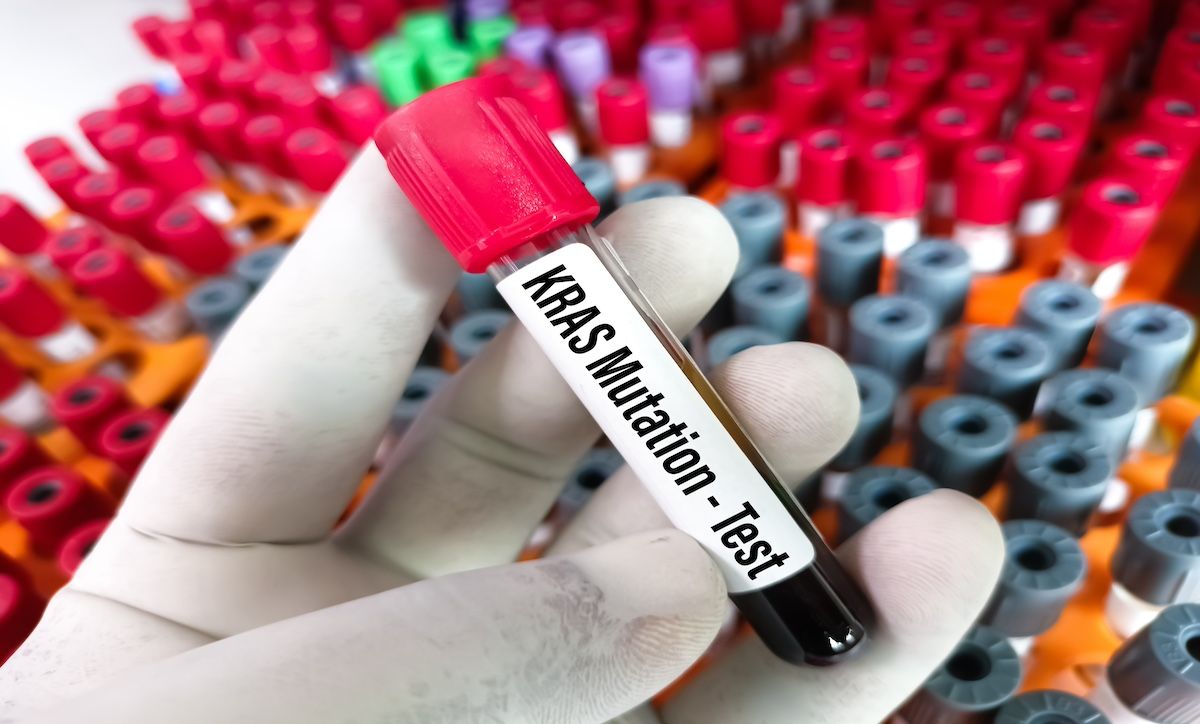News
Article
Real-World Data Show Sotorasib Effective for NSCLC With KRAS Mutation
Author(s):
Data from real-world and clinical-trial settings on frontline monotherapy treatment with the KRAS inhibitor sotorasib both show similar progression-free survivals and a high likelihood that the treatment’s efficacy is not affected with dose reduction.
Real-world patient data from June 2021 through February 2023 show that among a cohort of 128 patients who received the KRAS inhibitor sotorasib for their KRAS G12C–mutated non–small cell lung cancer (NSCLC) through the Veteran Health Administration (VHA), progression-free survival (PFS) was similar to that seen in the phase 2 CodeBreaK100 trial. In addition, incorporating a dose reduction did not equate with ineffective treatment, according to the newest data published in JTO Clinial and Research Reports.1
The current approved daily dose of sotorasib is 960 mg.
Sotorasib is the first targeted treatment approved for KRAS G12C–mutated non–small cell lung cancer | Image Credit: Arif Biswas-stock.adobe.com

The FDA first approved sotorasib for use in this type of lung cancer—making it the first targeted treatment for this mutation-specific NSCLC—following at least 1 line of treatment through its accelerated approval pathway in May of 2021, based on CodeBreaK100 (NCT03600883) data showing an objective response rate of 36%, a 10-month median duration of response, and a disease control rate (DCR) of 81%.2,3 At that time, the FDA has asked for postmarketing data on efficacy at the lower dose of 240 mg vs the approved 960 mg.1,3 However, in January of this year, the FDA issued a complete response letter to Amgen’s request for full approval of sotorasib, requesting additional patient data.4
Patients included in the present analysis (n = 128) were retrospectively identified from the Corporate Data Warehouse; all had been prescribed sotorasib through the VHA before March 1, 2023. Their median age was 72 years (range, 43-93), 90% were male patients, 77% reported a White/Caucasian race, 19% reported a Black/African American race, 95% reported a non-Hispanic ethnicity, 69% were former smokers, adenocarcinoma was the most common histologic diagnosis (91%), and stage IV disease was the most common disease stage at sotorasib initiation (94%). The study investigators cited the need for real-world data on the drug’s safety and efficacy as to why they conducted this analysis.
Ninety-two patients were included in the response analysis, and among them, the overall response rate (ORR) was 34%, the DCR was 71%, the median time to response was 2.4 months, and the median duration of response was 4 months. For the entire 128-patient cohort, median treatment duration was 6.3 months, median PFS was 6 months, and median overall survival (OS) was 12 months.
Seven patients also had active central nervous system disease at sotorasib initiation, and of them, 1 had a partial response to sotorasib, 1 had stable disease, and 2 experienced disease progression.
Sixteen patients were treatment naïve when they initiated sotorasib. Their median PFS and OS were 6.6 months and 8.1 months, respectively. The most common reasons for lack of prior chemotherapy were anticipated intolerance (n = 8), patient refusal (n = 6), and receipt of systemic therapy for another malignancy (n = 2). Top reasons for lack of first-line treatment with immune checkpoint inhibitors (ICIs) were anticipated lack of efficacy (n = 9), not known (m = 4), and patient refusal (n = 2).
A univariate analysis that considered STK11 mutation, KEAP1 mutation, glomerular filtration rate greater than 60 mL/min, and Eastern Cooperative Oncology Group performance status (ECOG PS) of 3 or higher found associations between each of these and decreased PFS; only PD-L1 tumor proportion score of 50% or greater was linked to improved PFS. A multivariate analysis found only ECOG PS of 3 or higher to convey a higher risk (HR, 4.2; 95% CI, 1.28-13.75).
Thirty-seven percent of patients required dose interruption or reduction, with those who received ICIs within 3 months of sotorasib initiation having higher rates of treatment interruption, reduction, or discontinuation. Among those who required a dose reduction, the most common lower dose was 480 mg in 62%; 27% went on to receive 240 mg, and 11%, 720 mg.
Limitations on the authors’ findings include its retrospective nature, which enabled them to only consider treatment-related toxicities that led to sotorasib interruption, dose reduction, or discontinuation. Because of this, they may have seen higher rates of all 3 compared with a clinical trial population.
“Additional prospective evidence is needed to clarify the relationship of sotorasib dose with drug tolerability and clinical efficacy,” they concluded.
References
1. Zhou KI, Lin C, Tseng CL, Ramnath N, Dowell JE, Kelley MJ. Brief report: real-world efficacy and safety of sotorasib in U.S. veterans with KRAS G12C-mutated NSCLC. JTO Clin Res Rep. 2024;5(5):100670. doi:10.1016/j.jtocrr.2024.100670
2. FDA approves first targeted therapy for lung cancer mutation previously considered resistant to drug therapy. News release. FDA. May 28, 2021. Accessed May 17, 2024. https://www.fda.gov/news-events/press-announcements/fda-approves-first-targeted-therapy-lung-cancer-mutation-previously-considered-resistant-drug
3. Rosa K. FDA approves sotorasib for KRAS G12C–mutated NSCLC. OncLive®. May 28, 2021. Accessed May 17, 2024. https://www.onclive.com/view/fda-approves-sotorasib-for-kras-g12c-mutated-nsclc
4. Wahner A. FDA issues complete response letter to sotorasib for KRAS G12C–mutated NSCLC. OncLive. January 2, 2024. Accessed May 17, 2024. https://www.onclive.com/view/fda-issues-complete-response-letter-to-sotorasib-for-kras-g12c-mutated-nsclc





